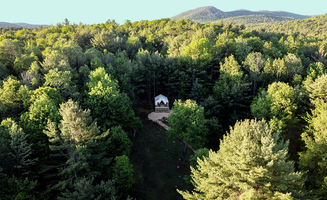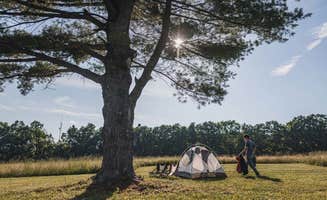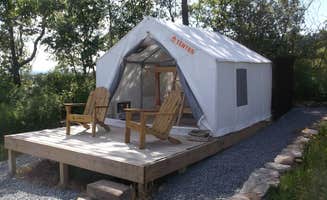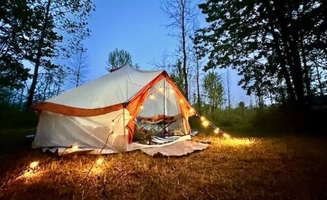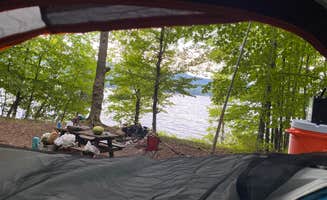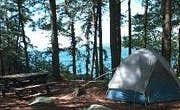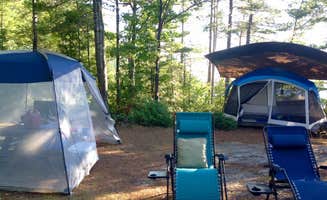Tent camping near Northville, New York offers experiences in the southern Adirondack region at elevations ranging from 800 to 1,500 feet. Seasonal considerations significantly impact camping conditions, with summer temperatures typically ranging from 55-80°F and frequent afternoon thunderstorms common in July and August. Winter camping requires specialized gear as temperatures regularly drop below freezing from November through March.
What to do
Paddle local waterways: Cedar River provides calm waters ideal for paddling with a small launch area accessible from Cedar River Entrance Camping. Matthew D. noted, "There is a small landing to launch kayaks or canoes. A dam with some additional sites on the other side."
Island exploration: Lake George offers unique island camping opportunities. One camper described the experience at Glen Island Group: "We rented kayaks and actually reserved a spot on our own private island. It was little, slightly wooded, and private."
Mountain biking trails: The region contains extensive trail networks through varied terrain. At Ushers Road State Forest, a reviewer mentioned, "This trailhead provides access to bicycle-friendly nature trails. I explored both directions on my bike, riding approximately half a mile down each side."
Fishing opportunities: Multiple water bodies support diverse fish populations. Justin B. from Glen Island noted, "Great fishing, lots of fun to be had on the water and quiet peaceful evening by the campfire."
Trail hiking: The area contains numerous marked trails with varying difficulty levels. Tony F. described Murphy Lake trail conditions: "Well marked with blue Trail Blazers, the trail snakes its way through the wilderness. Passing by two other bodies of water, Bennett and Middle Lakes, you pass through rocky, rooted terrain and pine tree barrens."
What campers like
Water access: Many campers appreciate proximity to lakes and rivers. At Long Island Group, Anastasiia T. shared, "Beautiful view, chill atmosphere, easy boat parking on the slip."
Privacy levels: Several dispersed sites offer seclusion despite road proximity. At Cod Pond, Josie W. found, "Decent site right off of the 'main' road. 'Main' because it was quiet. Easy to access via a short dirt road, but also easy to miss."
Free overnight options: The canal system provides no-cost camping opportunities. Mona M. reviewed E16 Canal Lock: "The Canal Corporation provides designated spots for tent and van camping along the canal. Stays are limited to a maximum of 48 hours. Upon arrival, campers must scan the QR code at the entrance and complete a brief survey."
Natural surroundings: The region offers camping within mature forest ecosystems. The L. observed at Ushers Road State Forest: "About 500 feet down the right-hand trail, there is a smaller path branching off to the left. This leads to a previously used campsite, approximately 200 feet from the main trail."
Seasonal variations: Different seasons offer distinct camping experiences. At Long Island Group, Richard T. simply stated, "Great island camping with amazing views," while others noted the seasonal availability from May through October.
What you should know
Access challenges: Some sites require significant effort to reach. Tony F. described Murphy Lake Leanto: "A two hour bike ride with a couple of breaks. The Murphy Bennett Trails is a technical challenge to hike, or bike in on. And be prepared to go over downfalls."
Vehicle limitations: Many sites restrict vehicle size or require specialized transportation. At Cod Pond, Taylor A. warned, "A car is not recommended. Possible to turn around but you definitely need a smaller SUV."
Water sources: Drinking water availability varies significantly between sites. Campers at dispersed sites should filter water from natural sources or bring their own supply, as most locations lack potable water facilities.
Site conditions: Ground surfaces often present comfort challenges. Taylor A. noted at Cod Pond: "Plenty of space for multiple tents, ground may look flat but when sleeping-definitely is not."
Reservation requirements: Policies vary by location. Island sites typically require advance booking, while many forest sites operate on first-come, first-served basis with varying stay limits.
Tips for camping with families
Accessibility considerations: Choose sites with manageable access for younger campers. Elizabeth P. recommended Stony Creek Family Campground: "It's a nice family ran campground. We love it here and plan to come back!"
Wildlife encounters: Prepare for potential animal visitors, especially at established sites. Ryan from Long Island Group warned: "We were literally bombarded with a group of raccoons each night. It was bad."
Insect protection: Bug pressure can be significant, particularly near water. Taylor A. from Cod Pond stated directly: "The bugs were terrible."
Site selection timing: Arrive early for non-reservable sites, especially during summer weekends when locations fill quickly. Cedar River campsites typically fill by Friday afternoon during peak season.
Water safety: Many sites offer water access without supervision. Justin B. from Glen Island shared family insights: "Me the wife and our 3 children had an amazing time on our three night stay. Definitely no amenities other than an outhouse but spectacular views and pristine waters."
Tips from RVers
Size restrictions: Most tent camping areas near Northville have limited or no RV accommodations. Justin B. from Glen Island advised: "Definitely need a decent sized boat with a gas outboard to get there," highlighting the boat-in nature of many sites.
Alternative parking: Some areas prohibit RVs but offer parking nearby for tent access. Smaller trailers under 20 feet can sometimes access Cedar River Entrance Camping, though no hookups are available.
Cell service considerations: Connectivity varies widely across the region. At E16 Canal Lock, Mona M. noted: "The Verizon signal is good in the area," while most forest sites have limited or no service.
Supply planning: Limited services mean bringing all essentials. Campers at Murphy Lake Leanto must carry all supplies for their stay, with the nearest resupply point requiring significant travel time.




